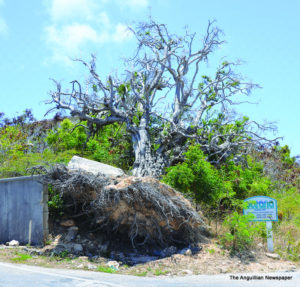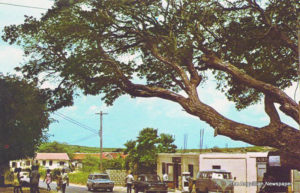As Anguilla celebrates the 52nd anniversary of its famed Revolution, we take time out to pay some attention to the humble role which two noteworthy trees played prior to, and after, the turn of political events that changed our nation’s history.
In an era when Anguilla was rather primitive in its mode of advancement, trees served as useful sources of shade, meeting pl aces, as well as for providing landmarks and physical points of reference. Trees facilitated our people who were little more than humble in their outlook, yet determined in their resolve for change. There were prominent trees in various Anguillian communities, back in the day, and these, in one way or another, added to the modest nature of Anguilla’s “make-do” way of life.
aces, as well as for providing landmarks and physical points of reference. Trees facilitated our people who were little more than humble in their outlook, yet determined in their resolve for change. There were prominent trees in various Anguillian communities, back in the day, and these, in one way or another, added to the modest nature of Anguilla’s “make-do” way of life.
Like Anguillians, two renowned, unique trees, though not indigenous to Anguilla, played significant roles in the island’s culture and its history. These were the Mahogany Tree and the Milky Thorn Tree.
The Mahogany Tree was actually the name given to the central area of business and commerce where peasant farmers, fishermen, butchers, and other vendors sold their goods in an era when Anguilla was but a stranger to economic development. This tree provided a central place where public notices were posted and important meetings were held. It was one of the key places on the island for casual social interaction.
“The Tree”, as it was colloquially called, was a spreading, shady, gigantic one that stood near the intersection of the spot where Malliouhana Travel Agency and the DHL offices now stand, across from Lake’s Haberdashery. Worthy of emphatic mention, “The Tree” was the scene where island folk from all walks of life chanced to meet and chat about island issues.
In addition, The Mahogany Tree was the site of one of the island’s main “stand-pipes” where many way-worn travelers would stop to “cup their hands” and bow a bit to savour a cool, refreshing drink of water — and rest for a little while. The Mahogany Tree: it has been the scene of many island stories, and it had heard many stories from the folks who gathered beneath its faithful boughs.
Legend holds that the Mahogany Tree was more than a hundred years old, for generation after generation would remember and relate its forbidding history. Until its fateful fall in 1971, “The Tree” stood as a testament to Anguilla’s simple, but noble lifestyle.
The other prominent tree worthy of historic notoriety is the Milky Thorn Tree. This remarkable landmark bears a rich source of our island’s history as well. Located near the old Cottage Hospital, just in the corner under the gentle hill that leads to Lloyd’s Bed & Breakfast, the Milky Thorn Tree has been vital to The Valley folk, and the adjacent communities, for ages.
This one too, would be hundreds of years old, because succeeding generations would have benefited from it as a natural, environmental resource that contributed to the island’s way of life. Unfortunately, the recent winds of Hurricane Irma caused havoc to this hallowed tree, plucking it from its age-old roots and leaving it to stand almost as a pitiful derelict. And though it may still stand in a virtually upright position, the Milky Thorn Tree might pass away if no attention is paid to it.
In an interview with a media representative, Mr. Ralph Hodge, information on the significance of the Milky Thorn Tree was provided for the purpose of this article. Mr. Hodge hails from The Valley area — the community that once revered the Milky Thorn Tree. He grew up sharing experiences that now form memories in the tree’s honour, and he is proud of the fact that his mother, Ruby Reid-Connor, who is almost a hundred, could testify to the significance of the Milky Thorn. Most of the rest of this story consists of quotations from Mr. Hodge himself:
“It is remarkable that you are
also writing about the Mahogany Tree,” Mr. Hodge said. “I learned in growing up that the distance from the Milky Thorn Tree to the Mahogany Tree is exactly one mile to the east. My mother, Ruby, is a Reid from Crocus Bay. She told me that as she was growing up, the Milky Thorn Tree was already an old mature, sturdy tree. She said her parents also grew up meeting it as quite a large, shady tree which meant much to the surrounding villagers.
“The Milky Thorn Tree was a meeting place for villagers from the Prison Bottom, Lower North Valley, Roaches Hill, Crocus Bay, and the Old Court House Hill. It was used as a gathering place where the fishermen would meet before going fishing down in the Bay, and after coming up the hill from fishing they would gather there to wash themselves

under the stand-pipe before dispersing to their abodes.
“The Milky Thorn Tree’s stand-pipe provided water for the entire district. With the absence of any significant cisterns in those days, one would have relied on bringing water home from the pipe. And we youngsters had to make several trips to the pipe at the Milky Thorn Tree to fetch water for our homes. We would also take our cows to a small trough, near the tree, to drink water from the pipe. It was there where boys and girls from the villages chanced to meet socially, because in those days there was very little interaction between boys and girls, seeing that there was a separate boys’ school and a separate girls’ school. Boys and girls were, for the most part, kept apart. But it was the Milky Thorn Tree that brought us together. The village’s boys and girls were free to catch water there, and to chat with each other, and to socialize there.
“The area of the Milky Thorn Tree was central because the old Cottage Hospital was next door, Lloyds Hotel was nearby, the old prison and the courthouse was up the hill from Lloyds, and down the road was the Methodist Church.
“The Milky Thorn Tree was virtually holy domain for The Valley boys. If you know the areas of Anguilla very well, there are certain things which were common to each community; and it was the Milky Thorn Tree which was central to our community. When one looked to the east of the tree there would have been corn fields; to the north there would have been corn fields; and corn fields were also to the southwest. The Milky Thorn Tree was in the centre of the villages’ activities.
“When people from the other districts would bring patients to the hospital, it was under the Milky Thorn Tree that the vehicles would park and wait. We, boys, would then have a chance to inspect the several engineering features of the vehicles and note their characteristics. We took pride in the Milky Thorn Tree.
“In the 1967 Revolution, there was a cistern just south of the Milky Thorn Tree which gunmen used as a cover — a point from which they fired at Lloyd’s Guest House in the political frenzy and confusion of the day. On the day following the shootings, spent shells were found around the old cistern in the area of the Milky Thorn Tree.
“But the Milky Thorn Tree was also a “spooky” tree for us, youngsters, growing up, for it was considered that since there were no lights, the Milky Thorn Tree was a place where jumbees lived at night time. So, by nightfall, especially for the younger folks, all activity at the Milky Thorn Tree would cease because, superstitiously, it was thought that the ghosts of the people who died in the hospital would be dwelling in its branches.
“One remarkable thing about the Milky Thorn Tree is that, for the generations who were nurtured under it, there are few of us left now. Many people of that era have died, while others have migrated to other places. But our children need to know the history and cultural significance of such things like the Milky Thorn Tree. My children do not know much about it. And hardly anyone in this current generation pays any significance to these features of our national history. But we must document the importance of these landmarks so that our youngsters and their children would know of our history.”
Mr. Hodge is of the view that the Milky Thorn Tree can be revived if a project is undertaken “to stand it up erect again.” He said it would take some delicate engineering, but perhaps the Anguilla National Trust, or the Archaeological Society, can possibly take on this preservation venture.
Staff Writer, James R. Harrigan







